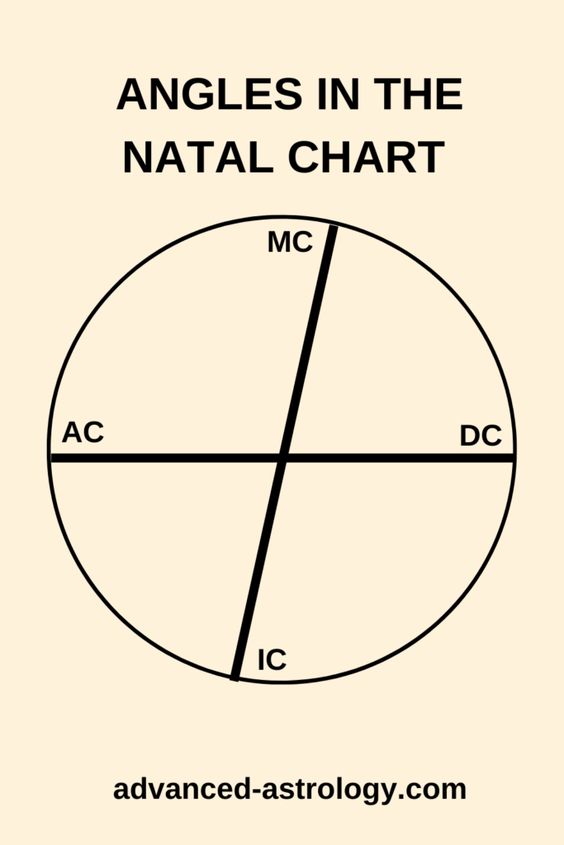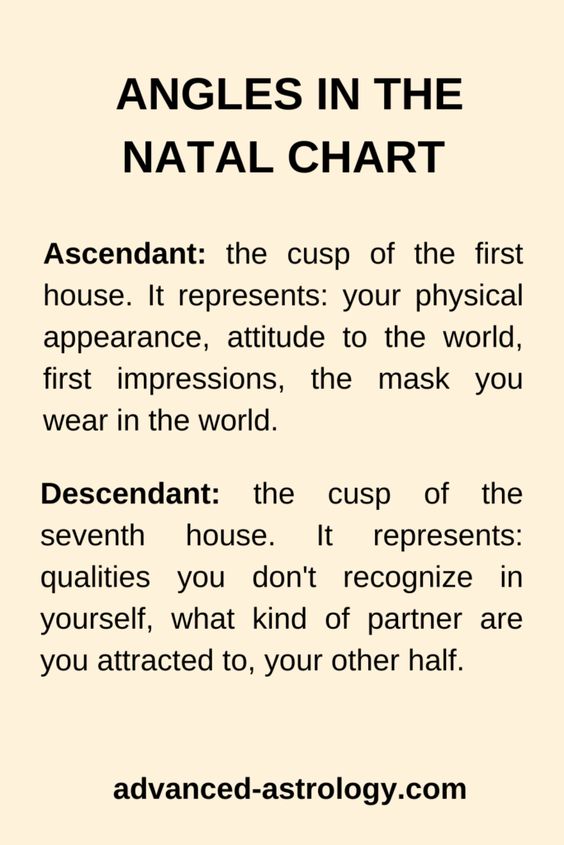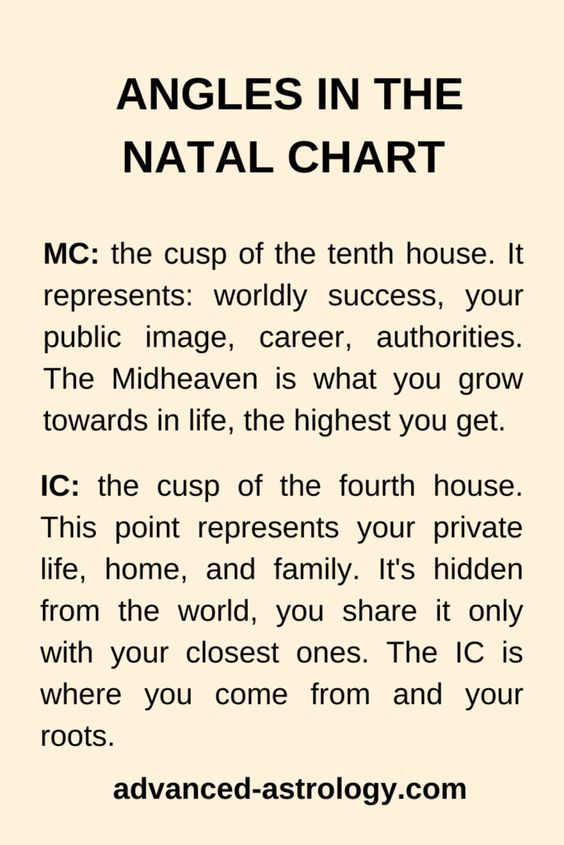If you have dabbled in astrology, you have probably heard the words ascendant and descendant, Midheaven and Imum coeli thrown around. If you are not sure about what they mean, don’t worry. You’ll learn about their meaning in the birth chart in this article.
The ascendant and descendant, MC and IC are called the angles in astrology.
They are among the most important components of a horoscope. They are so important that they are always displayed in the chart. However, to find out where your andes are in your chart, you will need your exact birth time. They are the fastest-changing components of a horoscope, changing signs every few hours. In some cases, even a difference of 15-30 minutes can make a difference. The sign on the ascendant and descendant, MC and IC is highly personal, let alone their degree, which changes every four minutes.
The angles are special by default, however, any planet close to an angle becomes more powerful as well. The areas around the angles are very important. Planets located close to them are called angular planets, and they have an enormous influence over the chart.
Let’s dive into this important topic!

The Angles in the Birth Chart
As mentioned before, there are four angles in the natal chart: the ascendant and descendant, the MC, and the IC. MC stands for Medium Coeli, Latin for the center of the sky, while IC is short for Imum Coeli, the bottom of the sky in Latin.
Why are the angles so significant in astrology?
They show the facets of your personality regarding the four fundamental aspects of your life. The signs on the ascendant, descendant, MC and IC show your role in the life areas associated with the house that belongs to the angle. They have a lot to do with your identity, an essential part of who you are.
If you look at a birth chart, the angles are usually marked with a thicker line. They are the cusps of the first house of self-identity (the ascendant), the fourth house of family and roots (the IC), the seventh house of relationships (the descendant), and the tenth house of professional life (the MC).
In the picture below, you can see the two axes of the birth chart. The ascendant-descendant angles make one axis of the natal chart (the horizontal one), while the IC-MC angles make the other axis (the one that’s approximately vertical).

These lines called the axes divide the chart into hemispheres. The ascendant-descendant axis divides the horoscope into the upper and lower hemisphere. The lower hemisphere was below the horizon as seen from the place of your birth at the time of your birth, while the upper hemisphere was above it.
The lower part of the horoscope is associated with how you subjectively perceive life, and the unconscious. The upper hemisphere is more of an objective experience and how you consciously experience the world, what you achieve.
People who have an emphasized lower hemisphere tend to be more introverted, while those with several planets in the upper hemisphere are usually extroverted.
The MC-IC axis divides the chart into the Western and Eastern hemispheres.
The ascendant is the Eastern part of the natal chart. This area of the natal chart symbolizes you as an individual and it’s linked with the self. The descendant part of the horoscope is about you working together with other people around you.
The distribution of the planets through the hemispheres tells a lot about your personality: more planets in the eastern hemisphere suggest a person who is individualistic and independent, while a heavier emphasis on the western hemisphere indicates a cooperative personality who doesn’t like to lead and do things on their own. Regarding the upper and lower hemisphere, if the majority of the planets fall in the upper hemisphere, the native is ambitious, determined, outgoing, while the majority of the planets below the ascendant and descendant angle implies a calm personality who values the peace of the everyday life over making it in the world.
The Ascendant and Descendant Axis in the Natal Chart
The Ac-Dc axis is essential when it comes to reading a birth chart. It reveals a lot of information about how someone perceives themselves, others, but also about how the other person perceives them.
The ascendant and descendant are the cusps (depending on the house system) of opposite houses. They are far from each other, separated but connected at the same time. People are usually very aware of their ascendant, but lose sight of their descendant. However, they are both parts of you and both are needed.
Here’s what the ascendant and descendant mean in astrology!
The Ascendant in Astrology
Most people who want to go beyond their Sun sign continue their astrological journey with their rising sign. The rising sign is the same as the ascendant, it’s the sign that was rising on the eastern horizon at the moment of your birth, as seen from the place of your birth. It’s the point on the ecliptic that ascends on the eastern horizon.
Because of the rotation of the Earth, the sign here changes approximately every two hours (the degree changes every four minutes). As you can see, it’s essential to know your birth time to calculate your ascendant!
The rising sign is a crucial building block of your natal chart. It’s often abbreviated as Asc or As in the birth chart. To find your rising sign, you have to know your exact time of birth (here’s what to do if you don’t now when you were born).
Understanding the ascendant is key when it comes to self-discovery. The ascendant is your identity, your attitude to the world and the world’s attitude to you. It is also associated with your physical appearance and body.
The ruling planet of the ascendant is called the chart ruler, and it is a central element in the birth chart.
Read more: the Ascendant through the Signs
The Descendant in Astrology
The descendant is, on the other hand, the point on the ecliptic that goes down on the western horizon. It’s the point exactly opposite of the ascendant in the birth chart. The descendant is the cusp of the seventh house in the natal chart (or it falls in the 7th house, depending on the house system you use).
This angle is located the furthest from the ascendant. The ascendant represents you, and the qualities of the sign on the descendant are somewhat hidden. They are in the shadow, and we don’t really recognize them in ourselves.
Because of this, we often seek them in others. Understanding the ascendant and descendant help you a lot when it comes to love and relationships. It helps you uncover the patterns that repeat themselves in this life area. The descendant represents the qualities you unconsciously want in a partner and the kind of people who attract you.
You have to know your exact birth time to calculate your descendant. The sign on the descendant is always the opposite of the sign on the ascendant.
Read more: the Descendant through the Signs

The MC and IC in Astrology (Midheaven and Imum Coeli in the Natal Chart)
The MC-IC axis is the other axis in the natal chart besides the ascendant and descendant. The IC and MC in astrology speak about where you come from figuratively speaking (but also literally!) and where your soul wants to go in this lifetime, what qualities you are growing towards.
Just like the ascendant and descendant, the Midheaven and the IC are intertwined, too. On the surface, they seem to represent two drastically different life areas, but one cannot exist without the other. They belong together, even if they are separated at the same time.
The Imum coeli in Astrology
Often abbreviated as IC, Imum Coeli is Latin for the bottom of the sky. It’s the point of the ecliptic that corresponds to the lowest point of the sky, as seen from the place of your birth at the time of your first breath. Correspondingly, it’s the lowest point in your natal chart. The IC is also called Nadir.
Usually the least talked about, the IC tells about your innermost self. This is the self you don’t show to anyone except people who you are very close with. It’s your inner awareness. As the cusp of the fourth house of home and family, the IC reveals what habits and thought patterns you got in childhood. When talking about the IC-MC axis in astrology, you can’t forget that this is the parental axis as well. It represents on the parents.
The sign on the Imum coeli tells about your childhood upbringing and nurturing, your family, and your emotional self. It is not just about you, but about your ancestors as well. The fourth house and the IC in astrology are about transgenerational beliefs and traumas. It often indicates blockages you feel but you can’t quite put your finger on.
The fourth house and the IC are associated with your memories and the subconscious, so accessing them is not as easy and straightforward as it is for the ascendant and descendant. However, it’s essential to do this work, because the IC lays the foundation of your whole adult life. It’s a cliche, but no tree can grow if it has no roots. The IC and the fourth house show your roots.
Understanding the fourth house helps you create the life you want in the tenth house on a solid foundation.
The Midheaven in Astrology
The Midheaven is the opposite point of the Imum coeli. Often abbreviated as MC, the Midheaven is Latin for the middle of the sky. It’s the part of the ecliptic where the local meridian intersects it. It’s not the same as the zenith, the highest point directly above us.
The Midheaven is the cusp of the tenth house in the natal chart. It’s associated with ambition and career, success you find in the world.
While the IC represents your intuitive and emotional child-self, the MC rectifies these energies and gives them a socially acceptable packaging. This angle is about outward expression. It shows how you react with society and what’s your soul’s strategy to succeed in it.
Read more: the MC through the Signs

If you found this article helpful, maybe you want to save it for later. Make sure to share it with your friends who enjoy learning astrology!